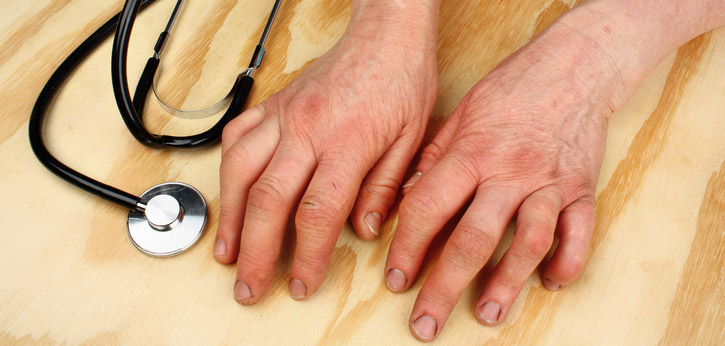It comes as a surprise to many that more than 50 million adults have been diagnosed with arthritis, representing 1 in every 5 adults in the United States. Most people first experience joint inflammation symptoms in their hands. The early stages are characterized by a dull or burning sensation, morning stiffness, and pain after periods of extended joint usage; and these symptoms can intensify and worsen as hand rheumatoid arthritis becomes more severe in the subject. Whether you are just beginning to encounter symptoms or you are at a more advanced stage of the disease, there are many means of taking control of your symptoms and reducing the effects of your disease. It’s your life – don’t let rheumatoid arthritis rule you!

Photo by handarmdoc / CC by
1. Healthy Habits
There is no single solution that can cater to every individual’s requirements and lifestyle, but there are subtle changes your doctor may advise in the interest of improving your condition. To provide your body with the fundamentals it requires to combat rheumatoid arthritis, studies suggest that consistent patterns of rest, relaxation, and exercise are paramount factors. 8 hours of sleep per night is recommended for RA patients. If you struggle with insomnia and cannot fulfill the nightly quota, you should consider taking a nap in the afternoon. Reducing stress can also aid in relieving pain. Meditation, breathing exercises, and hypnosis are suggested to reduce stress and achieve a heightened level of relaxation.
To promote muscle fluidity, regular low-impact exercise is encouraged. Tai chi, swimming, walking, and water aerobics are highly endorsed options– just remember, don’t overexert yourself! Performing daily hand stretches can also grant you noticeable improvements in range of motion, strength, and flexibility – it’s like yoga for your hands, so there is no better hand rheumatoid arthritis treatment!
2. Medication & Supplements:
The most common oral remedies as rheumatoid arthritis treatments include , hydroxychloroquine, , and oral corticosteroids. Each has their unique characteristics to combat the specific symptoms for each individual subject. If you require a quick relief for a temporary flare up, oral corticosteroids are an ideal solution. and both suppress immune system responses to decrease inflammation. Over the long term, hydroxychloroquine reduces pain, swelling, and joint stiffness, but it may not yield results until 12 weeks of use. Talk to your doctor and describe your pain symptoms to ensure you receive the proper prescription.
If you determine that your current symptoms do not require a prescribed oral remedy, you may want to consider the use of aspirin nonsteroidal anti-inflammatory drugs (NSAIDs) to temporarily relieve pain and decrease feelings of discomfort. However, these over-the-counter solutions do not prevent the course of rheumatoid arthritis, and thus you may be at risk of entering a more detrimental stage of the disease. There are also reports that suggest fish and plant oil supplements can aid in reduced pain and stiffness, but the degree of effectiveness is yet to be determined. Can’t hurt to try, right?
3. Topical Solutions
In addition to – or in lieu of – medication and supplements, topical solutions may be utilized to provide temporary relief of joint pain. Topical options come in a variety of forms, including those of spray, gel, lotion, cream, and patch varieties. Most options are available over-the-counter and do not require a prescription. The ideal topical solution will include menthol, diclofenac sodium, camphor, capsaicin, or salicylates, as they achieve the greatest results in temporarily alleviating hand arthritis pain. Topical solutions have the added bonus of convenience. It is practical to carry a supply with you in case you should encounter periods of sensitivity and pain throughout the day. Some hand arthritis sufferers swear by their topical treatments as it is a means of attaining relief with less risk and fewer side effects.
However, if you have hand rheumatoid arthritis in more than a few joints, topical usage may not be enough to combat your symptoms. Be sure to research brands of interest before use, as some topical solutions are not recommended for use in tandem with certain prescriptions for rheumatoid arthritis treatments. If you prefer to steer clear of topical treatments, you may find relief in applying hot and cold compresses. Cold compresses can help to numb the pain and relax muscles; a heating source can alleviate tense muscles and stiffness. Take a nice, long bubble bath and you’ll feel physically and mentally relaxed!
4. Surgery
While surgery is an option as a hand rheumatoid arthritis treatment, it is one that is relatively rare in comparison to other arthritis-related procedures. According to a 2009 study conducted by the Agency for Healthcare Research and Quality, doctors performed fewer than 1,000 hand surgeries in comparison to almost one million knee and hip replacements that year. The lack of surgeries is attributed to an array of associated risks, including decreased hand mobility and a high failure rate. For people with extremely agonizing symptoms, the risk may yield a reward worth their while. A fusion surgery, or arthrodesis, entails fusing the bones of the joint together to create a more stable, pain-free knuckle. However, fusion surgeries can drastically decrease flexibility. A replacement surgery, or arthroplasty, involves removing the damaged joint and inserting an artificial implant. However, this option too reduces finger motion. If your knuckle is not the focal point of your arthritic pains, there are a number of alternative surgical procedures that target areas of discomfort in the fingers, fingertips, or base of the hand, which have more promising results.
5. Assisted Devices
23 million of those diagnosed report limitations in their ability to perform day-to-day activities due to ongoing arthritic joint symptoms. If you begin to have trouble managing everyday activities due to your hand arthritis symptoms, self-help devices can make living with your condition a bit easier. There is a wide range of products available to keep joints in the most comfortable position, provide stability, leverage when needed, and extend the capacity of flexibility and motion of joints. A splint is a low cost and practical device option for hand arthritis sufferers, offering increased support in the areas where you need it most. But there are hundreds of products and tools to reduce exertion and allow you to maintain your independence, from arthritis-friendly eating utensils, can openers, gripping mechanisms, to tub bars, hands-free tools, zipper pulls, and buttoning aids.
If you’re interested in pursuing any of the treatment options listed above, talk to your doctor to choose the course of action that’s right for you.
Featured Image Source: Thinkstock/Adam88xx
Posted on February 15, 2023



